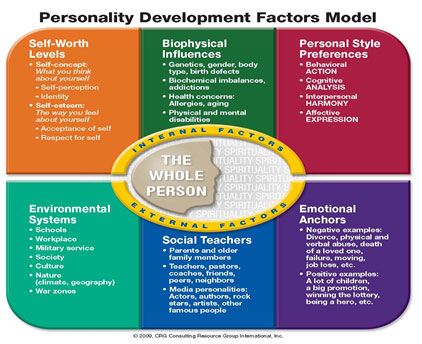A Holistic Approach to Professional Development: An Introduction
By Ken Keis
Are we Nature or Nurture?
Are we a product of nature (born that way) or nurture (input from our environment)? The answer is we are a combination of both nature and nurture. Each person is born with many parts that form the whole. We gain knowledge and beliefs (nurture) as we participate in life.
Let me explain. Your Personal Style strongly affects everything you choose to do and the way you choose to do it. Even though you may have learned how to display behaviors that are unrelated to your Personal Style, your style always has an impact on your decision-making; it serves as a filter system through which all your learned behaviors must pass.
Our Personal Style greatly influences the many adjunct styles of behavior that you will develop during your lifetime. Personal Style is the foundation for your interpersonal or social style.
The totality of you as a person is called your personality—all the inputs, conditions, characteristics, and behaviors that combine to create your Personal Style, along with all the socially learned behaviors you have acquired.
The Uniqueness of You
Your personality is exclusive to you alone. No one else in the history of time has been or will be exactly as you are.
To turn out the same way you have, other people would have to live your life exactly as you have lived it. They would need to possess, from the moment of conception, the same genes that determined, among other things, the color of your eyes, the shape of your ears, and the texture of your hair. They would have to be brought up under exactly the same conditions you experienced in childhood, play all the games you played, suffer all the falls you took, and learn all the lessons you learned.
In fact, they would need to experience everything in precisely the same way you did to produce a person with your unique hopes, fears, desires, values, and characteristics. Even then, your gifts, talents, and abilities are genetically yours so there is little opportunity that any two individuals will ever be exactly the same.
As an example, during an episode of Star Trek, The Next Generation, Commander Riker was beamed up from the surface of a planet. Unknown to the crew, a mirror image of Commander Riker was reflected back to the surface. Up to that point, the two were identical individuals in every way.
For the next five years, however, the second Commander Riker survived under hostile conditions on the planet. When The Enterprise returned and discovered the second Commander Riker, it was clear that the men were no longer identical. Their experiences over the five years had shaped them differently, even though they were clones when the duplication occurred. That shows the uniqueness that the events in our lives add to each of us.
It’s extremely difficult to assess just how important any one factor has been in creating your personality. How much weight can be given to any single factor?
There’s no simple answer, and the presence of so many factors makes it all the more complex. That difficulty poses a further challenge because one of the factors that has exercised—and continues to exercise—a significant effect over your personality is your Personal Style. Consequently, to explain the special influence of your Personal Style, we need to distinguish it from the roles other key factors have played in your life.
Personality Development Factors Model™
To capture a more holistic perspective of how we perceive and interact with the world, CRG developed our propriety model: The Personality Factors Development Model. This model acknowledges people’s diversity and provides a framework for understanding the whole person.
You’ll notice the three factors in the top half of the chart are called internal factors; they affect your personality “from within” because they emanate directly from inside your body or mind. The factors in the bottom half are called external factors; they are more dependent on stimulation from phenomena “from outside” yourself.
The factors represent the different kinds of influences present to some extent in the lives of all human beings, regardless of gender, race, or culture. The strength of the influence coming from factors within each of the categories may vary for each individual, however.
For example, everyone’s life is strongly influenced by biophysical factors such as genetics, but not always in the same way or to the same extent. Even when two individuals do have the same disability, the condition does not affect their lives in exactly the same way.
We’ll look at each factor separately to examine the role played by the various factors within each category and how they influence personality development.
This is the first of a seven-part series. Read Part Two.
Ken Keis is considered a global authority on the way assessment strategies increase and multiply your success rate. In 22 years, he has conducted more than 2000 presentations and 10,000 hours of consulting and coaching. Author of Why Aren’t You More Like Me? Discover the Secrets to Understanding Yourself and Others, Ken can be contacted at 604 852-0566, info@crgleader.com, or through www.whyarentyoumorelikeme.com.








